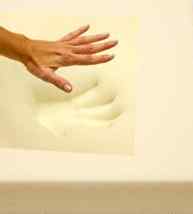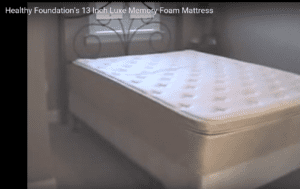What is Healthy Foundations?
Healthy Foundations is best known for its 10” Healthy Foundations Memory Foam Mattress. Notably, with hundreds of reviews, this mattress still received a 5-star average – most mattress models with 100 or more reviews (this mattress has over 400) do well to get a 4.7 or 4.8 average.

How did Healthy Foundations begin? With a skiing accident. Attorney David Rosenberg injured his back, and the chronic, recurring pain drove him to look for a better mattress. In the mid-1990s, he found a Tempur-Pedic memory foam mattresses (this was early in the history of memory foam mattresses – Fagerdala World Foams introduced the first ones for consumers in Sweden in 1991, and the next year started Tempur-Pedic to sell them in North America.[1]
Why Memory Foam?

Rosenberg found that memory foam relieved the pain in his back. The “memory” in memory foam is the slow rebound, remembering the shape of the sleeper’s body. It does this because it softens as it warms up with body heat. This evenly distributes support, reducing pressure on larger joints (such as shoulders and hips) and keeping support for the smaller areas (such as the lower back).
Entering the Market
In 1994, he began selling memory foam mattresses, working with a US manufacturer to make them to his specifications. In 1998, he began selling online. Sometime before 2015, the 10” Healthy Foundations Memory Foam Mattress (HF-10) became his only model, the 5-star one.
The HF-10 has not been the only model. The mattress review site GoodBed has a listing of the Healthy Foundations 13″ Luxe Memory Foam Mattress. Also online are a 2009 video introduction of this model and a 2008 Healthy Foundations announcement.
Rosenberg used only foams made in the United States, though for a while he sold mattresses made in Spain. The reason? Quality. Factories in China have problems with quality control, unlike foams made in the U.S. and Europe. All of his foams are certified by CertiPUR-US.
Latex, Too
Healthy Foundations is for more than just memory foam. It is also for latex. Along with memory foam, David Rosenberg also studies and writes on this major mattress material. Rosenberg stresses the importance of 100% natural latex (all rubber tree sap). About 2008 Healthy Foundations sold latex mattresses. If he had them now, he could find latex with a GOLS cerification
A Lawyer’s Mind at Work
Rosenberg also studied memory foam, becoming an expert in this material. He shares many of the views of Dr. Rick Swartzburg of Relief-Mart, the Editor-in-Chief of Memory Foam Mattress.Org. The Healthy Foundations website has several pages of information about memory foam, buyers guides, and a blog with over 290 posts. He also wrote about latex. Not all of the posts are authored by him. The past couple of years, some have been written by Angela L. Hensley.
David Rosenberg no longer sells the mattress. He cites “supplier issues” and “a health crisis” for discontinuing sales, but still maintains the site, including a description of the 10” Healthy Foundations Memory Foam Mattress. Healthy Foundations now serves as an information resource about memory foam.
The Mattresses
10” Healthy Foundations Memory Foam Mattress

The 10” Healthy Foundations Memory Foam Mattress is described as a “five-layer” mattresses. This is counting the cover as the top layer. There are four foam layers, two 3” polyurethane foam support core layers and two 2” memory foam comfort layers.
Both of the support layers are 2.3 lbs. in density and have an “egg crate” top surface. The “egg crate” configuration is for horizontal airflow for cooling.
The upper comfort layer of the HF-10 is 4-lb. memory foam, and the lower layer is 5-lbs. This is essentially the same as the Tri-Pedic by Selectabed.
Originally, Tempur-Pedic mattresses had only one memory foam layer, which was 5-lbs. or more. Dr. Swartzburg found that it was hard until it heated up, then yielded, so he designed the Tri-Pedic with 4-lb. memory foam on top for a quicker initial response, and 5-lb. foam under that for greater conformity and pressure relief.
Rosenberg says the memory foam is open-cell to allow passage of air through the foam. It seems to have worked, even if not as efficiently as the Airflow Transfer System by Selectabed, which is an option for the Tri-Pedic and a standard feature for Tempflow mattresses and the Snuggle-Pedic Mattress.
The cover fabric of this mattress is made with CoolMax fibers. Made by Invista (a DuPont spin-off), CoolMax is polyester extruded with channels in the fibers to wick moisture. It was designed to be employed in performance fabrics for use in clothing worn by athletes and others in high heat or activities with great exertion. These fabrics have been adopted by several bedding manufacturers for mattress covers. Wicking moisture keeps the sleeping surface both dry and cool. And being in a knit or woven material preserves breathability.
Healthy Foundation’s 13″ Luxe Memory Foam Mattress

The Healthy Foundation’s 13″ Luxe Memory Foam Mattress, a pillowtop model, was introduced toward the end of 2008 and promoted in a March 2009 video.
David Rosenberg prefers memory foam from 4 to 5 lbs. density. Whereas the 10” Memory Foam Mattress has a 2” 4-lb. memory foam layer atop a 2” 5-lb. one, both memory foam layers in the 13” Luxe were 5-lb. density.
The top 2” layer of 5-lb. memory foam is in the pillow top. Just beneath this is another 2” of 5-lb. memory foam. Denser than 4-lb. foam, it is more heat sensitive. This means that it is firmer when cold and has to warm up before it has any meaningful give. It also means that it is more contouring and pressure-relieving.
This also means that it has a longer memory – a longer response time when the sleeper moves. For a sleeper who moves more often, this can create discomfort, which is why most memory foam mattress owners like lighter memory foam, even down to 3.3 or 3.2 lbs.
For older versions of memory foam, such as when the 13” Luxe was made, this may have been a problem in durability, but tests performed by Healthy Foundations’ mattress testing contractor with newer constructions of memory foam showed a better durability.
The polyurethane support core layer of the 13” Luxe was 7” high. The density was not listed – it was just called “high density.”
Between the support core and the comfort layer is another inch of foam. This is channeled foam to foster airflow. In the half of the mattress for the upper body, the foam is firmer for more support.
The additional inch of the mattress height is accounted for by the quilted CoolMax cover.
Shipping, Trial Period and Warranty
After launching the Healthy Foundations online store, Rosenberg eventually began compressing mattresses for easier and less costly shipping. This was before Casper Sleep made the big splash in the marketplace.
Healthy Foundations had a 365-day sleep trial/return period. There was a $70 return fee, which was waived if the mattress was donated. The warranty is for 10 years.
Evaluation and Comparison
Healthy Foundations made and sold good products, especially the 10”Memory Foam Mattress. This is evident from the reviews by customers. One customer going by the name of Daniel registered a complaint in 2012 on Mattress Underground, but other outside reviews of this model have been overwhelmingly good. The 13” Luxe did not get ratings as good, but this may be attributed to the heavier memory foam.

The Healthy Foundations 10”Memory Foam Mattress is essentially comparable to the Tri-Pedic by Selectabed. The primary differences are (1) the HF-10 has four layers, while the three Tri-Pedic models has three; (2) the HF-10 relies on it open-cell memory foam construction to move air through the memory foam, but the Tri-Pedic mattresses have the option of the Airflow Transfer System (ATS) with vertical ventilation (pores) in the memory foam; and (3) HF-10 uses convoluted (egg crate) top surfaces in its two support cores to move air horizontally to and from the mattress border, while ATS has airflow channels cut into the top surface of the support core.

